Guang Wang
GeoGen: A Two-stage Coarse-to-Fine Framework for Fine-grained Synthetic Location-based Social Network Trajectory Generation
Oct 09, 2025



Abstract:Location-Based Social Network (LBSN) check-in trajectory data are important for many practical applications, like POI recommendation, advertising, and pandemic intervention. However, the high collection costs and ever-increasing privacy concerns prevent us from accessing large-scale LBSN trajectory data. The recent advances in synthetic data generation provide us with a new opportunity to achieve this, which utilizes generative AI to generate synthetic data that preserves the characteristics of real data while ensuring privacy protection. However, generating synthetic LBSN check-in trajectories remains challenging due to their spatially discrete, temporally irregular nature and the complex spatio-temporal patterns caused by sparse activities and uncertain human mobility. To address this challenge, we propose GeoGen, a two-stage coarse-to-fine framework for large-scale LBSN check-in trajectory generation. In the first stage, we reconstruct spatially continuous, temporally regular latent movement sequences from the original LBSN check-in trajectories and then design a Sparsity-aware Spatio-temporal Diffusion model (S$^2$TDiff) with an efficient denosing network to learn their underlying behavioral patterns. In the second stage, we design Coarse2FineNet, a Transformer-based Seq2Seq architecture equipped with a dynamic context fusion mechanism in the encoder and a multi-task hybrid-head decoder, which generates fine-grained LBSN trajectories based on coarse-grained latent movement sequences by modeling semantic relevance and behavioral uncertainty. Extensive experiments on four real-world datasets show that GeoGen excels state-of-the-art models for both fidelity and utility evaluation, e.g., it increases over 69% and 55% in distance and radius metrics on the FS-TKY dataset.
UQGNN: Uncertainty Quantification of Graph Neural Networks for Multivariate Spatiotemporal Prediction
Aug 12, 2025



Abstract:Spatiotemporal prediction plays a critical role in numerous real-world applications such as urban planning, transportation optimization, disaster response, and pandemic control. In recent years, researchers have made significant progress by developing advanced deep learning models for spatiotemporal prediction. However, most existing models are deterministic, i.e., predicting only the expected mean values without quantifying uncertainty, leading to potentially unreliable and inaccurate outcomes. While recent studies have introduced probabilistic models to quantify uncertainty, they typically focus on a single phenomenon (e.g., taxi, bike, crime, or traffic crashes), thereby neglecting the inherent correlations among heterogeneous urban phenomena. To address the research gap, we propose a novel Graph Neural Network with Uncertainty Quantification, termed UQGNN for multivariate spatiotemporal prediction. UQGNN introduces two key innovations: (i) an Interaction-aware Spatiotemporal Embedding Module that integrates a multivariate diffusion graph convolutional network and an interaction-aware temporal convolutional network to effectively capture complex spatial and temporal interaction patterns, and (ii) a multivariate probabilistic prediction module designed to estimate both expected mean values and associated uncertainties. Extensive experiments on four real-world multivariate spatiotemporal datasets from Shenzhen, New York City, and Chicago demonstrate that UQGNN consistently outperforms state-of-the-art baselines in both prediction accuracy and uncertainty quantification. For example, on the Shenzhen dataset, UQGNN achieves a 5% improvement in both prediction accuracy and uncertainty quantification.
A First Look at Predictability and Explainability of Pre-request Passenger Waiting Time in Ridesharing Systems
Aug 12, 2025Abstract:Passenger waiting time prediction plays a critical role in enhancing both ridesharing user experience and platform efficiency. While most existing research focuses on post-request waiting time prediction with knowing the matched driver information, pre-request waiting time prediction (i.e., before submitting a ride request and without matching a driver) is also important, as it enables passengers to plan their trips more effectively and enhance the experience of both passengers and drivers. However, it has not been fully studied by existing works. In this paper, we take the first step toward understanding the predictability and explainability of pre-request passenger waiting time in ridesharing systems. Particularly, we conduct an in-depth data-driven study to investigate the impact of demand&supply dynamics on passenger waiting time. Based on this analysis and feature engineering, we propose FiXGBoost, a novel feature interaction-based XGBoost model designed to predict waiting time without knowing the assigned driver information. We further perform an importance analysis to quantify the contribution of each factor. Experiments on a large-scale real-world ridesharing dataset including over 30 million trip records show that our FiXGBoost can achieve a good performance for pre-request passenger waiting time prediction with high explainability.
Uncertainty-aware Predict-Then-Optimize Framework for Equitable Post-Disaster Power Restoration
Aug 06, 2025Abstract:The increasing frequency of extreme weather events, such as hurricanes, highlights the urgent need for efficient and equitable power system restoration. Many electricity providers make restoration decisions primarily based on the volume of power restoration requests from each region. However, our data-driven analysis reveals significant disparities in request submission volume, as disadvantaged communities tend to submit fewer restoration requests. This disparity makes the current restoration solution inequitable, leaving these communities vulnerable to extended power outages. To address this, we aim to propose an equity-aware power restoration strategy that balances both restoration efficiency and equity across communities. However, achieving this goal is challenging for two reasons: the difficulty of predicting repair durations under dataset heteroscedasticity, and the tendency of reinforcement learning agents to favor low-uncertainty actions, which potentially undermine equity. To overcome these challenges, we design a predict-then-optimize framework called EPOPR with two key components: (1) Equity-Conformalized Quantile Regression for uncertainty-aware repair duration prediction, and (2) Spatial-Temporal Attentional RL that adapts to varying uncertainty levels across regions for equitable decision-making. Experimental results show that our EPOPR effectively reduces the average power outage duration by 3.60% and decreases inequity between different communities by 14.19% compared to state-of-the-art baselines.
HCRide: Harmonizing Passenger Fairness and Driver Preference for Human-Centered Ride-Hailing
Aug 06, 2025Abstract:Order dispatch systems play a vital role in ride-hailing services, which directly influence operator revenue, driver profit, and passenger experience. Most existing work focuses on improving system efficiency in terms of operator revenue, which may cause a bad experience for both passengers and drivers. Hence, in this work, we aim to design a human-centered ride-hailing system by considering both passenger fairness and driver preference without compromising the overall system efficiency. However, it is nontrivial to achieve this target due to the potential conflicts between passenger fairness and driver preference since optimizing one may sacrifice the other. To address this challenge, we design HCRide, a Human-Centered Ride-hailing system based on a novel multi-agent reinforcement learning algorithm called Harmonization-oriented Actor-Bi-Critic (Habic), which includes three major components (i.e., a multi-agent competition mechanism, a dynamic Actor network, and a Bi-Critic network) to optimize system efficiency and passenger fairness with driver preference consideration. We extensively evaluate our HCRide using two real-world ride-hailing datasets from Shenzhen and New York City. Experimental results show our HCRide effectively improves system efficiency by 2.02%, fairness by 5.39%, and driver preference by 10.21% compared to state-of-the-art baselines.
InLINE: Inner-Layer Information Exchange for Multi-task Learning on Heterogeneous Graphs
Oct 29, 2024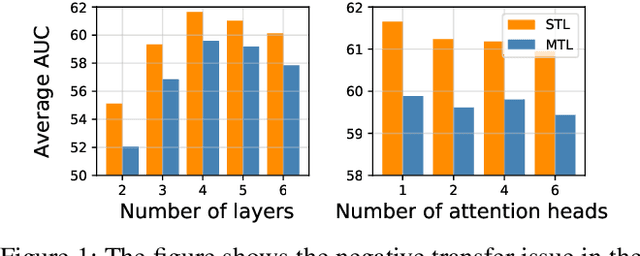
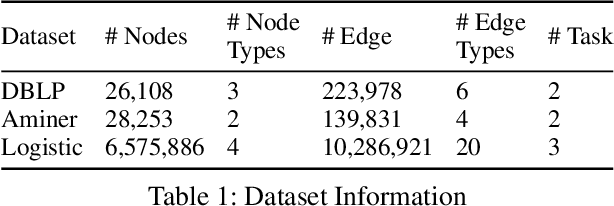

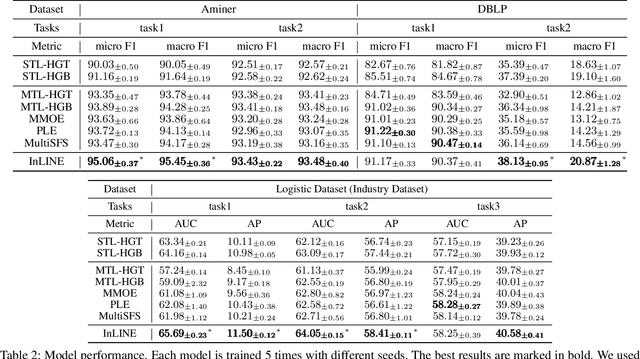
Abstract:Heterogeneous graph is an important structure for modeling complex relational data in real-world scenarios and usually involves various node prediction tasks within a single graph. Training these tasks separately may neglect beneficial information sharing, hence a preferred way is to learn several tasks in a same model by Multi-Task Learning (MTL). However, MTL introduces the issue of negative transfer, where the training of different tasks interferes with each other as they may focus on different information from the data, resulting in suboptimal performance. To solve the issue, existing MTL methods use separate backbones for each task, then selectively exchange beneficial features through interactions among the output embeddings from each layer of different backbones, which we refer to as outer-layer exchange. However, the negative transfer in heterogeneous graphs arises not simply from the varying importance of an individual node feature across tasks, but also from the varying importance of inter-relation between two nodes across tasks. These inter-relations are entangled in the output embedding, making it difficult for existing methods to discriminate beneficial information from the embedding. To address this challenge, we propose the Inner-Layer Information Exchange (InLINE) model that facilitate fine-grained information exchanges within each graph layer rather than through output embeddings. Specifically, InLINE consists of (1) Structure Disentangled Experts for layer-wise structure disentanglement, (2) Structure Disentangled Gates for assigning disentangled information to different tasks. Evaluations on two public datasets and a large industry dataset show that our model effectively alleviates the significant performance drop on specific tasks caused by negative transfer, improving Macro F1 by 6.3% on DBLP dataset and AUC by 3.6% on the industry dataset compared to SoA methods.
SAUC: Sparsity-Aware Uncertainty Calibration for Spatiotemporal Prediction with Graph Neural Networks
Sep 13, 2024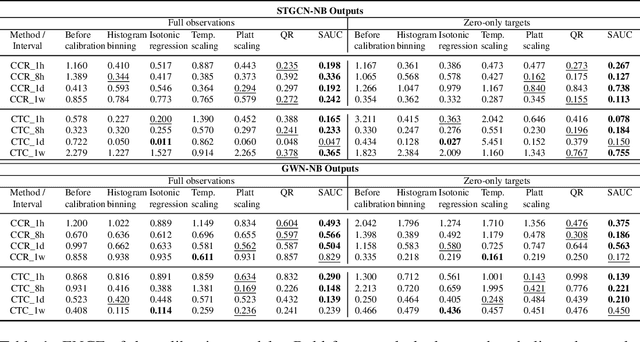


Abstract:Quantifying uncertainty is crucial for robust and reliable predictions. However, existing spatiotemporal deep learning mostly focuses on deterministic prediction, overlooking the inherent uncertainty in such prediction. Particularly, highly-granular spatiotemporal datasets are often sparse, posing extra challenges in prediction and uncertainty quantification. To address these issues, this paper introduces a novel post-hoc Sparsity-awar Uncertainty Calibration (SAUC) framework, which calibrates uncertainty in both zero and non-zero values. To develop SAUC, we firstly modify the state-of-the-art deterministic spatiotemporal Graph Neural Networks (ST-GNNs) to probabilistic ones in the pre-calibration phase. Then we calibrate the probabilistic ST-GNNs for zero and non-zero values using quantile approaches.Through extensive experiments, we demonstrate that SAUC can effectively fit the variance of sparse data and generalize across two real-world spatiotemporal datasets at various granularities. Specifically, our empirical experiments show a 20\% reduction in calibration errors in zero entries on the sparse traffic accident and urban crime prediction. Overall, this work demonstrates the theoretical and empirical values of the SAUC framework, thus bridging a significant gap between uncertainty quantification and spatiotemporal prediction.
FusionTransNet for Smart Urban Mobility: Spatiotemporal Traffic Forecasting Through Multimodal Network Integration
May 09, 2024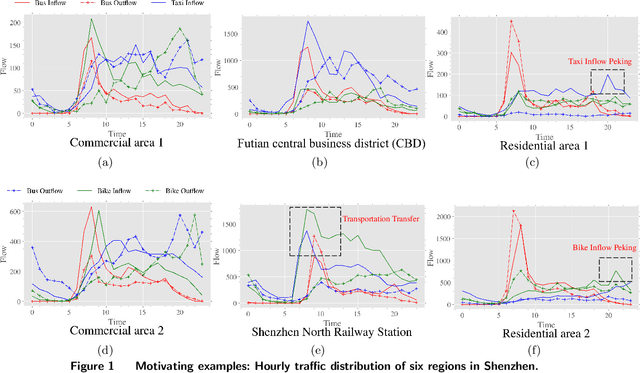
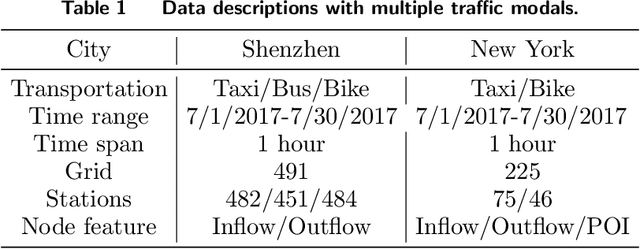

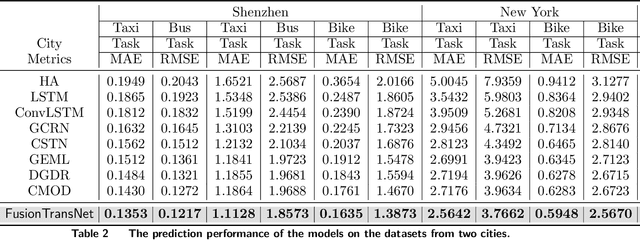
Abstract:This study develops FusionTransNet, a framework designed for Origin-Destination (OD) flow predictions within smart and multimodal urban transportation systems. Urban transportation complexity arises from the spatiotemporal interactions among various traffic modes. Motivated by analyzing multimodal data from Shenzhen, a framework that can dissect complicated spatiotemporal interactions between these modes, from the microscopic local level to the macroscopic city-wide perspective, is essential. The framework contains three core components: the Intra-modal Learning Module, the Inter-modal Learning Module, and the Prediction Decoder. The Intra-modal Learning Module is designed to analyze spatial dependencies within individual transportation modes, facilitating a granular understanding of single-mode spatiotemporal dynamics. The Inter-modal Learning Module extends this analysis, integrating data across different modes to uncover cross-modal interdependencies, by breaking down the interactions at both local and global scales. Finally, the Prediction Decoder synthesizes insights from the preceding modules to generate accurate OD flow predictions, translating complex multimodal interactions into forecasts. Empirical evaluations conducted in metropolitan contexts, including Shenzhen and New York, demonstrate FusionTransNet's superior predictive accuracy compared to existing state-of-the-art methods. The implication of this study extends beyond urban transportation, as the method for transferring information across different spatiotemporal graphs at both local and global scales can be instrumental in other spatial systems, such as supply chain logistics and epidemics spreading.
Information Cascade Prediction under Public Emergencies: A Survey
Mar 28, 2024



Abstract:With the advent of the era of big data, massive information, expert experience, and high-accuracy models bring great opportunities to the information cascade prediction of public emergencies. However, the involvement of specialist knowledge from various disciplines has resulted in a primarily application-specific focus (e.g., earthquakes, floods, infectious diseases) for information cascade prediction of public emergencies. The lack of a unified prediction framework poses a challenge for classifying intersectional prediction methods across different application fields. This survey paper offers a systematic classification and summary of information cascade modeling, prediction, and application. We aim to help researchers identify cutting-edge research and comprehend models and methods of information cascade prediction under public emergencies. By summarizing open issues and outlining future directions in this field, this paper has the potential to be a valuable resource for researchers conducting further studies on predicting information cascades.
Where have you been? A Study of Privacy Risk for Point-of-Interest Recommendation
Oct 28, 2023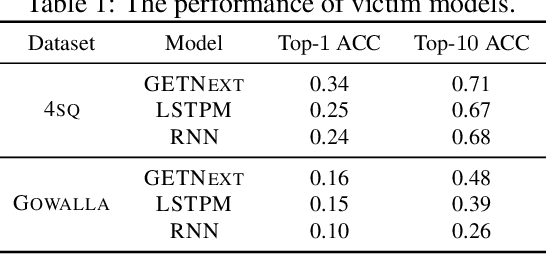


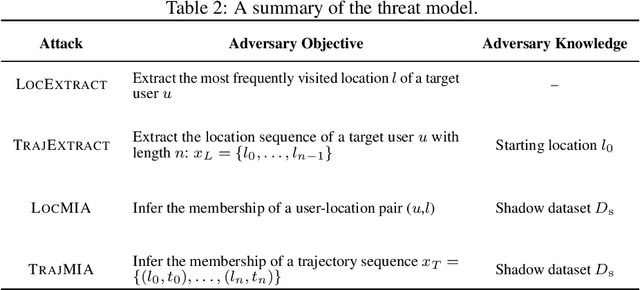
Abstract:As location-based services (LBS) have grown in popularity, the collection of human mobility data has become increasingly extensive to build machine learning (ML) models offering enhanced convenience to LBS users. However, the convenience comes with the risk of privacy leakage since this type of data might contain sensitive information related to user identities, such as home/work locations. Prior work focuses on protecting mobility data privacy during transmission or prior to release, lacking the privacy risk evaluation of mobility data-based ML models. To better understand and quantify the privacy leakage in mobility data-based ML models, we design a privacy attack suite containing data extraction and membership inference attacks tailored for point-of-interest (POI) recommendation models, one of the most widely used mobility data-based ML models. These attacks in our attack suite assume different adversary knowledge and aim to extract different types of sensitive information from mobility data, providing a holistic privacy risk assessment for POI recommendation models. Our experimental evaluation using two real-world mobility datasets demonstrates that current POI recommendation models are vulnerable to our attacks. We also present unique findings to understand what types of mobility data are more susceptible to privacy attacks. Finally, we evaluate defenses against these attacks and highlight future directions and challenges.
 Add to Chrome
Add to Chrome Add to Firefox
Add to Firefox Add to Edge
Add to Edge